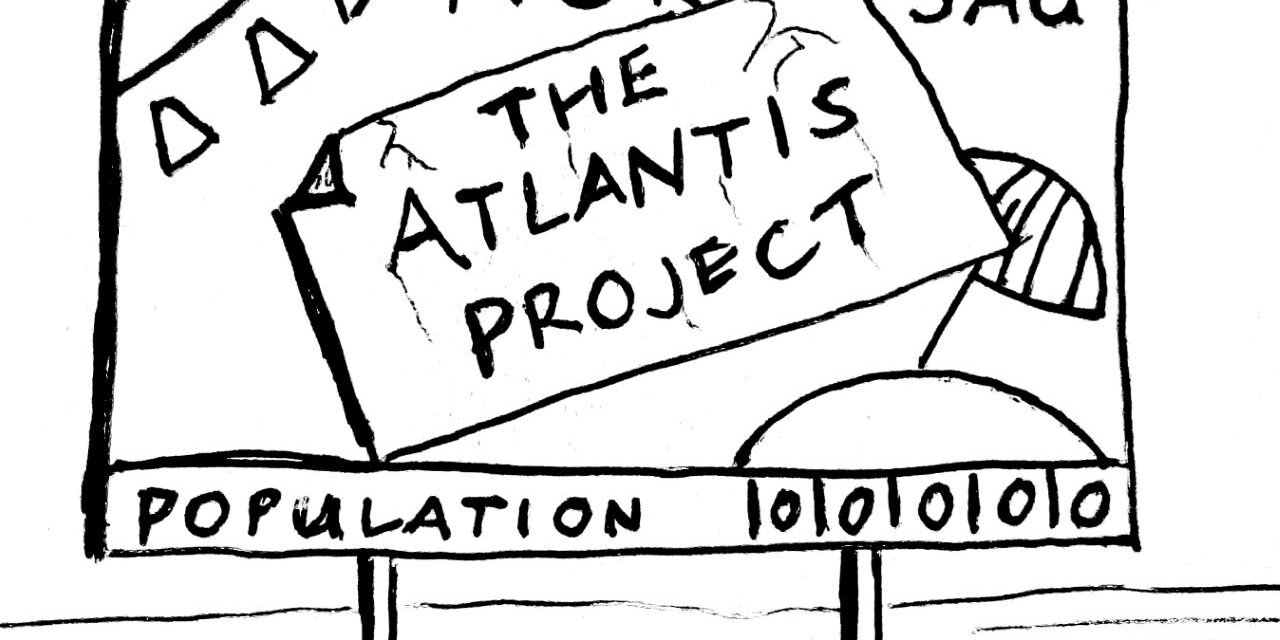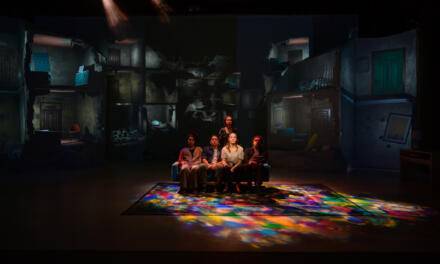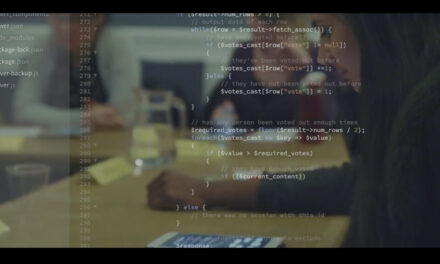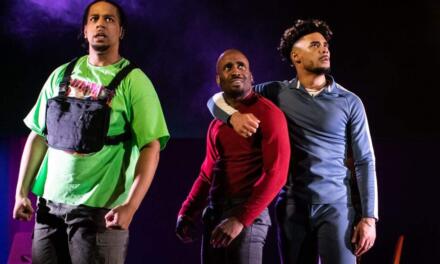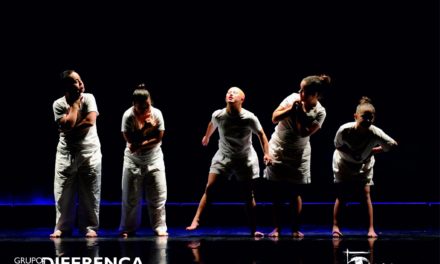It’s no secret that climate change is a universal topic, a subject that has only just begun to enter the theatrical sphere in earnest. But what happens when one shows such an important subject through the eyes of children? I sat down with Welsh theatremaker Chris Harris to discuss his new audio series, The Atlantis Project (co-created with Eliot Moleba), which illustrates the climate crisis through the eyes of two 13-year-olds, Evie and Deean, as their culture faces extinction. Along the way, we discuss why this topic is important for children to hear, the power of language and story, and the inherent intersection of climate change and cultural survival.
Rhiannon Ling: Let’s start from the very beginning. What inspired The Atlantis Project? How did you start working on it?
Chris Harris: The first thing wasn’t actually a subject matter. It was a collaboration with a dear friend of mine, Eliot Moleba, who is a South African artist now based in Oslo. We had been working on different projects in Wales since we met each other in 2014, and we had been looking for something to do that was going to connect Norwegian audiences and Welsh audiences. Last year, we had a first conversation about what subject matter is linking those two cultures, but would have some sort of universal outreach, as well. We talked a great deal about many different subjects, but it was evident that the most pressing subject of all was climate change. Now, of course, climate change is probably the biggest catastrophe that the world is facing at the moment, even beyond the pandemic that we’re all living through. Arguably, it’s probably part of the reason the pandemic is happening. Nonetheless, that’s when we began to start thinking about our audience, as well. Eliot, in particular, has worked a lot in children’s theatre and young person’s theatre. It’s something that I’ve very much wanted to do for a long time. And having done one other piece with him back in 2017—based on multiculturalism within Wales, in particular, and within rural communities—we decided that the two subject matters that link both of us, and both our interests and our passions, are climate change and culture.
So, we started digging around: I started doing a lot of Welsh research, and he was doing a lot of research from Norway, as well, and what big things are happening for them. And he very quickly brought to my attention an article that was talking about the native Saami people in northern Norway. The native Saami people, like many other different cultures across the world, are under threat because of rising sea levels. The threat is, of course, that with the rising sea levels, the communities will be lost and they will be forced back into heavily Westernized traditions, and, as a result, the big question is whether that culture will be lost as a result of said climate change. This is a really interesting topic that we thought hadn’t been explored as much culturally, from what we had seen. And then from my research, I did a lot of reading about the town of Fairborne, which is based in Gwynedd in the north of Wales, on the peninsula. Fairborne is one of the first towns in the UK that will be populated by climate refugees caused by rising sea levels. The difference with that community is, you have a community which is 70% non-Welsh, and the fear there is that they will be forced to integrate into communities that will be mostly Welsh speakers. The Welsh language community in Wales is very much concentrated between the west and the north, so there are many communities in north Wales, in particular, who all speak Welsh to each other. The fear there is, of course, that they will lose a culture that they’ve essentially manufactured themselves, which is not necessarily any kind of ancient or native culture, but one that has been manufactured by bringing two different cultures of the same country together.
So we decided, well, if we take both of these two influences together, then we can create our own fictional world in which this is affecting the community. Then, of course, we had to start thinking a lot about who the audience were and who we wanted to make this story to. Essentially, we thought, okay, well, adults are not listening anymore, but there’s a potential that children might, and that young people might be able to make a difference. Look at Greta Thunberg. So, we decided, well, the people we need to be appealing to are young audiences, in particular young audiences of a confident speaking age, which is why we decided that 11+ was a good age range to go to. But more than that, I, in particular, was very interested in looking at how we can create pieces of theatre that can be enjoyed by family members and by big groups of people. Once, someone in quite a high, privileged, powerful position in theatre in Wales told me that there’s no such thing as family theatre, which I thought was ludicrous. And I’m sure you think the same.
Ling: I absolutely do.
Harris: Yeah, so I’m out to prove him wrong, basically! Family theatre does exist, and the aim of The Atlantis Project is to create something that is aimed towards 11+, but we hope that it will be applicable to a wide age range. As a result, we follow two protagonists in the piece who are of that similar age—they’re about 13 in the piece, so slightly older—but we see what is happening to their culture and their community, ecologically and culturally, through their eyes, through quite two innocent eyes, really. As a result, we’re hoping that The Atlantis Project—itself, as a title, is sort of a metatheatrical device for an audience to be able to take with them—The Atlantis Project is a game that Evie, one of the two characters, uses, a childhood game that she plays on the beach with her friends, and it steadily, over the course of a year within the story, evolves to be climate protest that they create and then eventually give over to the listener. So that was the concept of it, but it very much began as “what could two artists from two different cultures make,” as opposed to “we want to make a piece about this.” It began with a relationship.
Ling: That’s amazing. And did you come to audio as the vehicle for the dissemination of this story first, or was that through experimentation and figuring out how you could reach the most people?
Harris: I think the latter thing of what you were saying is part of it. It has a lot to do with what restrictions are at the moment with the kind of pieces of theatre we can make. I’ve seen a lot of surging in podcasting and audio drama being made accessible and available online for people, but I don’t necessarily think that’s because it’s a cheaper and easier form of performance to make. I think it’s actually because the audio format allows for more interpretation and imagination. I mean, personally speaking, I gave up within the second or third week of lockdown trying to watch things that were in the Zoom frame, because they all look the same to me. To be able to do something in an audio format at least allows people to take the performance wherever they go. But also because it still invigorates the imagination that cinema can do. So that was part of the reason for making an audio series. And also, it has a lot to do with my personal experience of when I was growing up, of listening to audio stuff, as well. I used to sit in the back of cars, listening to old tapes of stories all the time, and they were always more creatively invigorating than anything else I was watching. At the same time, we are looking at this as making it an educational resource, which is the kind of longterm ambitions of the project. Using audio format might be a way of getting younger audiences engaged in storytelling a lot more: it’s an alternative to reading, it encourages skills of listening. Yeah. So those were the main reasons for making it an audio piece, I think.
Ling: Will it be accompanied by other forms of art, like visual art or film?
Harris: At the moment, no. I mean, my style is I use a lot of my own sketches to accompany any performance concept or series that I make—
Ling: Which are so fun, by the way! I looked on your website, and they’re very fun.
Harris: Oh, thanks! That’s a good thing, you see. And here’s the thing, right—again, this a personal standpoint, but—what we don’t seem to achieve as much in theatre is a rich, concrete visual imagery that cinema does. You look at the stuff that Wes Anderson makes, you can always say that that’s a Wes Anderson piece. You can always say that that’s a Stanley Kubrick film. I don’t feel that we have a similar kind of field, and we don’t have a kind of similar goal in theatre, which is not necessarily a bad thing. But I did think, how can we strive to make that? And part of the reason to use the sketches is to create a visual imagery that evokes what I’m trying to say and the kind of world that I have. So the image that you see of the billboard, I was thinking a lot of the billboard that’s in Jaws, the Amity Island one, that evokes this kind of summer place that also has an aspect of danger on it with that piece of paper that’s just stuck on it. So it evokes anarchy, as well, but in a childlike way. To have that element of anarchy on it—Atlantis Project is strapped right in the middle of it—gives you a sense of, this is the kind of world that we’re in. It’s an innocent quality that is for younger audiences, but it may not be as innocent as it seems. So to the visual quality, that’s what we’re striving for at the moment, but to go ahead and make an audio series that’s then gonna have any kind of extensive visual imagery is probably going against what we’re trying to make, so the answer is no, not really. The only other thing that we’re adding is, the week after its launch online, we’ll do some captioned versions in both Welsh and English, and that will probably be accompanied with more illustrations. But again, it’s not really a video format, it’s just a string of images together.
Ling: Let’s jump back a little bit, because I am so fascinated that this came about not from environmental justice originally, but from culture. You talked about kind of finding a mash-up of the Welsh and Norwegian cultures. I’d love to hear you talk a little more about that. How did you find that balance?
Harris: The thing about native Norwegian cultures and Welsh cultures is the fact that they are so much more ancient than Westernized cultures that we know now. And bridging those two things together allowed us to explore what the rituals of being a community is and, as a result…the thing is, I didn’t know a lot about the Norwegian culture until I actually visited the Norwegian church which is in Cardiff, and the Norwegian church celebrates Norwegian immigrants that used to come to Wales in the late 1800s/early 1900s, I believe. It shows how industry, in particular, was a good link between those two cultures, or two countries, I should say. So, the thing about, probably less in Norway, but the thing in Wales is there is always this kind of discourse that’s happening, where we believe we’re always trying to regrapple with the culture and regain who we are, given 700 years of English oppression. However, more so than ever, it’s probably fairer to say that Welsh culture has really found its feet now. In The Atlantis Project itself, Deean, who’s the second character of the piece, the 13-year-old boy, his culture is a fictional culture. It’s called Sagog, and Sagog is just this idea of this culture that’s been stood there for many generations and will never, ever be moved by any other rebellion or any culture of any kind, and it’s just ironic, then, that the climate is the thing that’s going to move them out, even though, through their rituals and through their culture, they have tried to worship Mother Nature, and there’s no standard god apart from Mother Nature. So, you can always say, specifically, what a Norwegian culture is. You know kind of what it is, whether it’s in cliché terms or in more detailed terms, and it’s always the same thing with Welsh, as well. In the UK, the Celtic nations have a much greater understanding of how they quantify themselves, and when you’re able to quantify yourselves, you’re able to protect yourselves a lot more and be more passionate about that, more patriotic. And when you’ve got something that you’re passionate about, patriotic about, then you become more protective of it. So, of course, when something like Mother Nature turns against you, well, you’ve got something to protect and you know what you’re trying to survive. I hope that answers your question.
Ling: It does! It kind of answers a different question, as well, which is: how does culture and climate change intersect in this piece? What are you hoping to illustrate?
Harris: Culture exists in fringes in some ways. Some more ancient cultures—I don’t think so much in Wales, but particularly with the Saami people—they’ve been pushed to the fringes because of Westernized traditions, they’ve been pushed to the fringes, geographically and literally to the edges of the world. And because the climate change is pushing them back into culture, it’s forcing them to question whether they’re gonna have to abandon what that means. Now, y’know, the death of our way of life is such a huge, huge thing in the climate change discourse. What a thing it would be to lose all ancient cultures and traditions and rituals as a result of this. The very fact that we can be responsible, in pockets of the world, for losing people’s communities and livelihoods…not just geographically losing land and losing resources, but losing thousands if not millions of years’ worth of life and livelihood. To us, to me, in particular, that is a huge tragedy. That’s the biggest tragedy of them all, because that’s the stories that we pass down to each other, y’know? Maybe it’ll have a positive outcome. I don’t know. Maybe we’ll adapt into some kind of new culture, which will then prolong, but you’d like to think that whatever happens in the next hundred years or so, that a little bit of what happened a thousand years ago will still remain, and I think culture is a way of communicating that.
Ling: Which is obviously so, so important to communicate with children, because, as you said, they are the people who are willing to listen and will hopefully pass that on. What do you hope that the children will gain from this? What do you hope they bring to their families afterward?
Harris: Initially, the love of storytelling is the reason why it became an audio series. It’s less performance-based, and more kind of storytelling-based. So being able, as a young listener, to relish in the story, that can also influence the first step. So if they can enjoy the story and connect to Evie and Deean’s characters, that would the first success, if you like. But, as Evie says at the end of the piece, “We’re giving The Atlantis Project to you, because our adults aren’t listening anymore.” We’re hoping that being able to create awareness to what’s happening to cultures across the world will allow them just to be more inquisitive and be more curious about the world. I don’t think that the world and education allows children to be as curious as they should be. And I think curiosity will allow them to go and find stories that are happening in the world and to go and share those stories with people, whether they do that creatively or not. Even Evie and Deean, in the piece, ask them to go ahead and put down those stories and to share those stories with the world. I hope that it will allow them to be inquisitive about the world that is happening to them, to share those stories, to also creatively engage with them in themselves, as well. I mean, we’ve talked a lot about how this will be an educational resource. Of course, theatre has this kind of stigmatism that it must be this one thing that is boxed within a black box, so to speak, but it would be a wonderful thing if we could try and tell younger people that there are other ways of being able to evoke performance, as well. So not only in content-wise I hope it will make a difference, but also as a form, a piece of theatre, that can say to young people—particularly students of theatre, as well, in secondary schools—that there are other ways of being able to tell stories and reach audiences. There are effective ways. I mean, in the UK, we are still fighting to keep these theatres open. Our government still is not giving enough substance and enough recognition to how important the cultural sector is to the human race. So to keep telling those stories in a metatheatrical way that says, people, we are telling you this story in this way, because this is how effective it is. If it does that, at the very least, then I feel like it’s succeeded.
Ling: You mentioned the captions in Welsh and English before this, and you do a lot of work in Welsh in general. How important is it to you to have all these stories told in a variety of different languages?
Harris: I mean, a language is a part of a culture, isn’t it? And part of a culture is storytelling and, through storytelling, we’re able to express ourselves as who we are as a culture. It’s a kind of translating thing. It’s like saying something makes sense in one language, but when you start to translate it from one to another, it doesn’t make sense, or it doesn’t resonate as much. The importance, of course, is to recognize that those cultures that we are speaking to still exist. Within Wales, those pockets of Welsh language audiences will want to hear those stories in their native tongue, because it will resonate with them a lot more. And that’s why it’s so important to do it in Norwegian, as well [as they have planned], because, despite the fact that Norwegians are incredibly well-spoken in the English language and learn it from quite a young age, I doubt it will resonate and communicate as well as it will in their own native tongue. And, in doing so, it creates a personal resonance when you hear something in your own native tongue, it creates a different experience and embodiment within you. So that’s why it’s important to be able to reach out in those different languages, particularly because it’s such a universal topic. It’s affecting everybody, so there’s no reason why this can’t resonate in several different languages.
Ling: One final question: is there anything else you’d like to tell us?
Harris: I think the most important thing to say is that theatre is changing, and the way that we are embracing culture and the way that we are experiencing and making it is changing, as well. So, in creating these stories, I, myself, as an artist, have been able to—with help from the Arts Council of Wales, and from Eliot, and from my co-creatives—I’ve been able to reinvent what I do and what I think about the world and what I think about theatre, and, in a way, this pandemic has been more a teacher than an enemy, I think. I hope that’s not too bold to say. What I mean by that is, I just hope that audiences will come as open-minded as possible to this, and that people will experience this as families and as groups of people, even though we are gearing it towards young audiences, and to feel that this is a story for everyone. I think that’s the last thing I want to say.
The Atlantis Project—created by Chris Harris and Eliot Moleba, starring Chris Harris and Roanna Lewis, and featuring sound design by Barnaby Southgate and music by Michael Lowe—will be available on AM, Soundcloud, and www.chrisharristheatre.com | https://www.amam.cymru/theatlantisproject beginning September 11th. That day, there is a launch at 6:30 pm GMT, where you can talk with the creators about the project and where it will grow next. Reserve your spot here.
The Atlantis Project will have captions in Welsh and English available on their YouTube channel beginning September 18th.
This post was written by the author in their personal capacity.The opinions expressed in this article are the author’s own and do not reflect the view of The Theatre Times, their staff or collaborators.
This post was written by Rhiannon Ling.
The views expressed here belong to the author and do not necessarily reflect our views and opinions.

